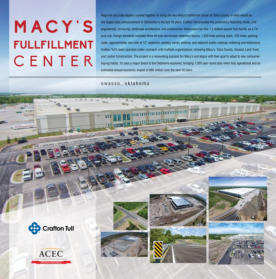
2015 Engineering Excellence Awards
2015 Grand Conceptor
HDR Honored as Engineering Excellence Award "Grand Conceptor" For Verdigris Water Treatment Plant
Problem: It seemed like a good idea back in 1979: Broken Arrow, population 35,000 at the time, would pipe its water in from the Oklahoma Ordnance Works Authority’s treatment plant 23 miles away and save some money. Fast forward 34 years, and you find a city of more than 100,000 relying on a single, quickly aging pipeline to meet its growing water needs. The single-source pipeline failed dramatically in 2013, when a rupture in the pipe left the city without water for several days. As a result, Broken Arrow issued a water emergency, the Tulsa County Health Department ordered Broken Arrow food establishments to cease operations and a boil order was issued.
Solution: The new Verdigris Water Treatment Plant—the first large membrane treatment plant in Oklahoma and one of the largest in the country—is the city of Broken Arrow’s largest-ever public construction project. The $58 million plant, finished on-time and $8 million below budget, is also the largest treatment plant ever funded by the Oklahoma Water Resources Board.
From the public’s perspective, for the first time ever, the water treatment plant offers complete control over their water supply—from water acquisition through primary and secondary disinfection to delivery to customers. The new plant uses a state-of-the-art membrane filtration system, which filters microorganisms better than conventional treatment methods by forcing water through extremely fine, porous tubes, allowing the city to use fewer chemicals.
The plant features a raw water intake and pump station on the Verdigris River, two pre-sedimentation reservoirs with a combined storage of more than 260 million gallons, a 31,000-square-foot membrane facility, a 6-million-gallon clearwell for storing finished water, a high-service pump station and three emergency generators, which can operate the treatment plant during power outages. The system reliably produces 20 million gallons per day (mgd) and is expandable to 40 mgd.
To accomplish disinfection, the Verdigris Water Treatment Plant uses free chlorine generated on-site as sodium hypochlorite for primary disinfection, and chloramines for secondary disinfection. These disinfection processes are significantly less dangerous than the chlorine gas and free chlorine commonly used for primary and secondary disinfection—producing fewer disinfection byproducts and creating a safer working environment for plant staff. Fluoride is also added for dental protection.
The facility’s pumps, variable frequency drives, pump control valves, and electrical equipment provide the highest energy efficiency practical and available on the market today. The new high-service pumps and raw water pumps both provide at least 25 percent higher efficiency than EPA Region 6’s standards—saving 2.4 million kilowatt hours, or $173,000, annually. The city received a $500,000 green infrastructure grant for utilizing the higher-efficiency pumps.
The facility contains an advanced laboratory for water quality testing and analyses, which has been used as a teaching lab for new employees, city staff and industry colleagues. It’s a case study for the rest of the state on advanced, state-of-the-art treatment plant design, which required the newly hired operations team to learn two new SCADA systems: one for the pumps, chemical dosing process and other systems, and one for the membrane system. The system includes a computerized control room, versus the analog room in the old facility, which allows most functions to be automated.
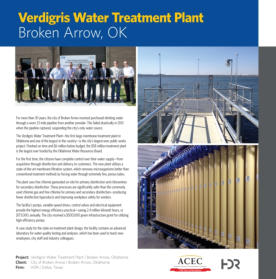
2015 Honor Award Winners
Leidos Engineering - Creek Turnpike Widening
The Creek Turnpike project included the design and plan production for approximately 41,400 feet of mainline widening of the existing four (4) lane roadway to six (6) lanes by adding two lanes along the center median. The western extent of the proposed improvements was US 75 and the eastern extent was South Memorial Drive.
The proposed mainline median widening transformed the existing 46-foot wide median from an open, depressed grassed median into a paved median consisting of an additional traffic lane and inside shoulder in each direction. The new median lanes and shoulders were constructed adjacent to the existing inside lanes.
The Creek mainline bridge improvements consisted of widening ten pairs of existing Creek Turnpike Bridges (20 bridges).
One major challenge of the project was that the timeline to design and let the project for construction was greatly accelerated. The originally planned 15 month design effort was compressed to 8 months to meet client needs.
Other challenges included:
- Design activities, coordination with affected public and private agencies along with communication with the Oklahoma Turnpike Authority had to be streamlined to efficiently maximize the available time and meet the project’s schedule.
- Coordination with affected public and private agencies began early on in the project, often with preliminary design information.
- Normal design milestone review meetings with OTA were replaced with review meetings approximately every two weeks.
- Utility relocation and constructability issues were discussed and analyzed early in the design process.
- Due to environmental concerns, certain project segments could only be constructed during specified months of the year. These environmental concerns had to be factored into the project design and the suggested sequence of construction.
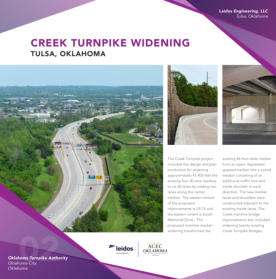
Leidos Engineering - I-44 / Lewis Avenue Interchange
The I-44/Lewis Avenue project consisted of the design of a new interchange at Interstate 44 and Lewis Avenue as part of overall corridor improvements proposed by the Oklahoma Department of Transportation along one of the most congested urban interstate corridors in the City of Tulsa. The overall corridor improvement and widening project extended along Interstate 44 from the Riverside Avenue to Harvard Avenue interchanges. The Leidos project included approximately 4,200 feet of I-44 mainline widening and reconstruction. This project included widening of the interstate from 4 lanes to 6 lanes with additional parallel acceleration and deceleration lanes. Approximately 1,500 feet of Lewis Avenue was also improved and widened, along with the frontage roads.
Project Challenges:
- Utility Relocation: Tight utility clearances for the relocation of existing sanitary sewer line and conflict resolution with proposed storm sewer line. Alternate design was prepared to eliminate conflict and limit cost overruns during construction.
- Leaking Underground Storage Tanks (LUST): Special design considerations included identification and avoidance of existing LUST sites under the existing perched water table conditions along the project corridor.
- Maintenance of Traffic (Construction Sequence & Traffic Control): Design focused on maintaining all four lanes (two lanes eastbound and two lanes westbound) of interstate traffic along I-44 for the project duration. Access to local businesses and residential areas along Lewis Avenue, 51st Street and the Westbound Frontage Road was also maintained during the project.
- Walls: Tall cast-in-place concrete retaining walls were required parallel to the mainline, up to 29 feet in height, adjacent to the new bridge at Lewis Avenue. The tall retaining walls required deep foundations supported on up to 7 foot diameter drilled shafts. Proximity of new bridge to existing bridge: The new bridge was constructed at the end of the existing bridge, with less than 30 feet between the end of the existing bridge and the start of the new bridge. The existing bridge structure was a single haunched concrete slab span structure, and the stability of the existing bridge (which still had traffic under it during construction) was a concern once the excavation began for the new bridge. This situation was carefully analyzed and a portion of the new bridge was not built until a later stage of construction to ensure the stability of the system.
- Freestanding Neighborhood Fence: The cast in place concrete freestanding neighborhood fence was supported using 2’-6” diameter drilled shafts. A double 8 foot by 4 foot reinforced concrete box crossed under the mainline and also under the freestanding neighborhood fence. A 4’-8” tall by 2’-6” wide concrete grade beam was designed to support the fence at the reinforced concrete box crossing since drilled shaft supports could not be used at this location.
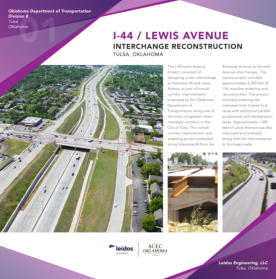
Freese & Nichols - Norman Comprehensive Transportation Plan
The City of Norman’s first-ever comprehensive transportation plan addresses thoroughfare, transit, pedestrian and bicycle planning in a single, cohesive document. It is the first time this city of 118,000 has approached transportation as a comprehensive planning activity, identifying and prioritizing needs, identifying funding, developing design standards and enabling the City to move quickly into pursuing funding and implementing prioritized projects across the spectrum of transportation modes and geographic locations.
The Firm led a consultant team that included the engineering firms of Garver and Alliance Transportation. They developed a comprehensive plan that encompasses all modes of transportation in the city. The team worked with a diverse, 45-member Citizens Visioning Committee (CVC) which split into four subcommittees:
- Automobile Capacity, Quality of Service and Parking
- Pedestrian and Bicycle Mobility, Safety and Streetscape
- Transit Capacity and Quality of Service
- Freight Movement, Airports and Emergency Response
As public meetings, hearings and City Council briefings progressed, the project team and the CVC identified five Guiding Principles encompassing 28 specific objectives. The team then delivered a multi-modal plan, including a complete streets ordinance, design standards, a trail and bike system and sidewalk gap analysis that was adopted unanimously by the City of Norman City Council.
The CTP has been followed by implementation of:
- A prioritized project to design and construct Rock Creek Road, including a proposed residential roundabout, bike lanes and an urban streetscape
- Applications for funding infrastructure improvements recommended in the Plan
- A recommended study regarding converting Main and Gray Streets from a one-way pair to two two-way streets.
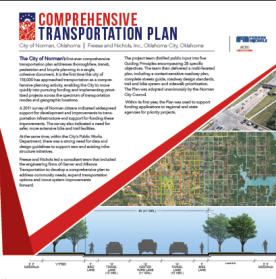
Guy Engineering - Crow Creek Drainage Improvement Project
After years of severe flooding, the historic neighborhood of East 21st Place and South Florence Place in Tulsa, OK has 62 fewer homeowners concerned about flooding, with the regulatory floodplain being removed from 39 homes. Concerned citizens worked with City of Tulsa and the consultant, to implement a park-like detention facility that provided relief from the flooding.
When The Firm was selected to engineer this project, the plan was to connect to an existing junction box under the Broken Arrow Expressway (BAX). However, the Firm determined that connecting to this junction box posed several challenges, including extended lane closures on the BAX and increased water flow downstream. Instead, The Firm proposed that the storm sewer relief line outlet into a dry, grass-lined detention facility immediately upstream of the BAX. While this solution required the acquisition of four properties, it eliminated impacts to the BAX and prevented negative impacts to the downstream storm system. This solution not only mitigated the flooding problem and removed 39 residences from the regulatory floodplain, but it also saved construction costs, reduced traffic disruption, and provided the neighborhood with a park.
The Firm’s design included innovations that reduced cost and increased value engineering. One innovation was using low-cost high performance turf reinforcement mat to provide erosion control for areas of higher velocity. The Firm also used precast reinforced concrete boxes to speed construction and reduce the time that residents were unable to access their driveways.
Affected residents were involved from the beginning of the project. Multiple public meetings were held to ensured that the final design addressed citizen concerns. For example, residents requested a park-like facility with grass and tree plantings, and the design was ultimately able to accommodate these requests. The Firm also took steps to ensure that each driveway was accessible at the end of the day and that citizens experienced no disruptions in their water and sewer services, and also included a landscaping plan to provide a sound and sight barrier from the highway.
This complex project, which took about nine months to complete, combined funding from multiple sources. Of the $2.2 million to complete the project, $1.5 million came from a FEMA grant; the other $700,000 was funds from the city's stormwater utility fee. City Councilor G.T. Bynum said it was a team effort to get it completed. “It was a bipartisan team of officials from the city, our state legislative delegation and our federal delegation all working together to promote this one project, in this one neighborhood.”
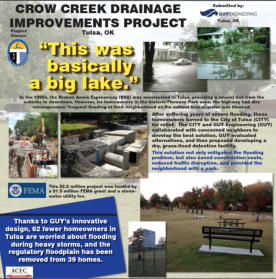
2015 Finalist Awards Winners
CEC - Extend & Light Runway 17-35 & Parallel Taxiway
In order to better support the civilian jet traffic at the airport, as well as the mission at nearby Vance Air Force Base, Runway 17/35 was extended 2,362’ to a usable length of 8,000’.
This new length will allow Air Force T-38s to now use the airport, and will provide increased safety to the corporate traffic and other Air Force trainers that currently use it.
In addition to providing more capacity and redundancy for 400 new Air Force student pilots each year, the extended runway at Enid Woodring Regional Airport will be an alternate landing site when Vance’s outside runway is reconstructed next year.
As a perquisite to extending the runway, 3 parcels of land were acquired and Southgate Road was re-routed, along with associated utilities, to provide adequate Runway Object Free Area as well as obstruction clearance for the approach to Runway 35.
In order to reduce the impact during construction to the airport, a temporary displaced threshold was installed on Runway 35, allowing all corporate tenants to continue to operate throughout the project.
During the project, the runway was only closed for a total of 4 days. The firm provided engineering, grant administration, and construction administration and inspection services on the $5.5 million project.
The full length runway is now open and capable of accommodating T-38 aircraft and will continue to bolster the economic impact the airport has on the City of Enid and northwest Oklahoma.

Poe And Associates - I-235 / 10th Street / Harrison Ave Interchange
The 10th Street corridor is anchored with St. Anthony Hospital on the west, Presbyterian Research Park (recently purchased by the University of Oklahoma) in the middle, and the University of Oklahoma Health Sciences Center on the east.
This project garnered tremendous support resulting in dedicated congressional funds. Upon receipt of these funds, the Oklahoma Department of Transportation (ODOT) selected the Firm to design the reconstruction of the existing I-235 northbound ramp to Harrison Avenue including a northbound exit ramp that would allow motorists direct access to 10th Street.
Working through several design concepts, the ultimate goal of the design team, in partnership with ODOT, was to find a design that would meet St. Anthony’s access needs as well as satisfy the access needs of additional stakeholders in the area.
Working closely with ODOT, the Firm completed a preliminary design of the project that involved the investigation of numerous alignments for the I-235/10th Street/Harrison Avenue ramp project accompanied by stakeholders meetings.
Input from these stakeholders meetings resulted in a unique and innovative final design that provide direct access to both Harrison Avenue and 10th Street from I-235.
Shortly thereafter, the Firm was notified that a proposed new development was planned for the project area and the project schedule would be accelerated to accommodate the construction and opening of the new facility.
The success of the project was only possible because of the tremendous cooperation and team effort by all entities involved, including the Oklahoma Department of Transportation, the City of Oklahoma City, St. Anthony Hospital, the Oklahoma City Urban Renewal Authority, and General Electric.
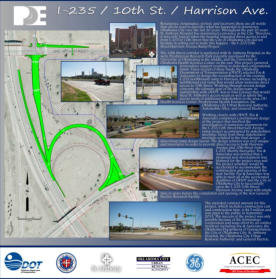
Crafton Tull - Macy’s Fulfillment Center
Regional and state leaders worked together to bring the new Macy’s fulfillment center to Tulsa County in what would be the largest jobs announcement in Oklahoma in the last 10 years. Key to landing the project were incentives offered by the governor’s office, the Cherokee Nation, the Oklahoma Department of Transportation, Tulsa County and the City of Owasso. Collaboration between these organizations and others in both public and private sectors was critical to attracting the milestone project to the state.
Macy’s is one of the largest internet retailers in the world, with more than $4 billion in annual e-commerce sales. The company announced plans to build a new 1.3 million-square foot direct-to-consumer fulfillment center in December 2013 to better serve its online customers and in response to the changing ways consumers buy and shop.
Months before the announcement, as Macy’s continued its site evaluation process that included consideration of more than 150 sites in multiple states, the Firm prepared a comprehensive feasibility study for the 74 acres on which the facility would eventually be built.
Once the site selection was finalized, Macy’s revealed its plans to construct the $170 million facility via a fast-track design-build process. A 12-month target completion date meant earthwork for the project needed to start as quickly as possible. The Firms site development team adapted a heavily compressed, front-loaded schedule to allow construction crews to begin work on time.
Site design elements included three off-site stormwater detention basins, 1,356 total parking stalls, 103 trailer parking stalls, approximately one mile of 12” waterline, sanitary sewer, platting, and adjacent public roadway widening and extensions. The Firm provided civil engineering, surveying, landscape architecture, and construction observation services, operating under contracts with multiple organizations, including Macy’s, Tulsa County, Owasso Land Trust, and Layton Construction.
The project is a resounding success for Macy’s and aligns with their goal to adapt to new consumer buying habits. It’s also a major boost to the Oklahoma economy, bringing 1,500 year round jobs when fully operational and an estimated annual economic impact of $80 million over the next 10 years.
